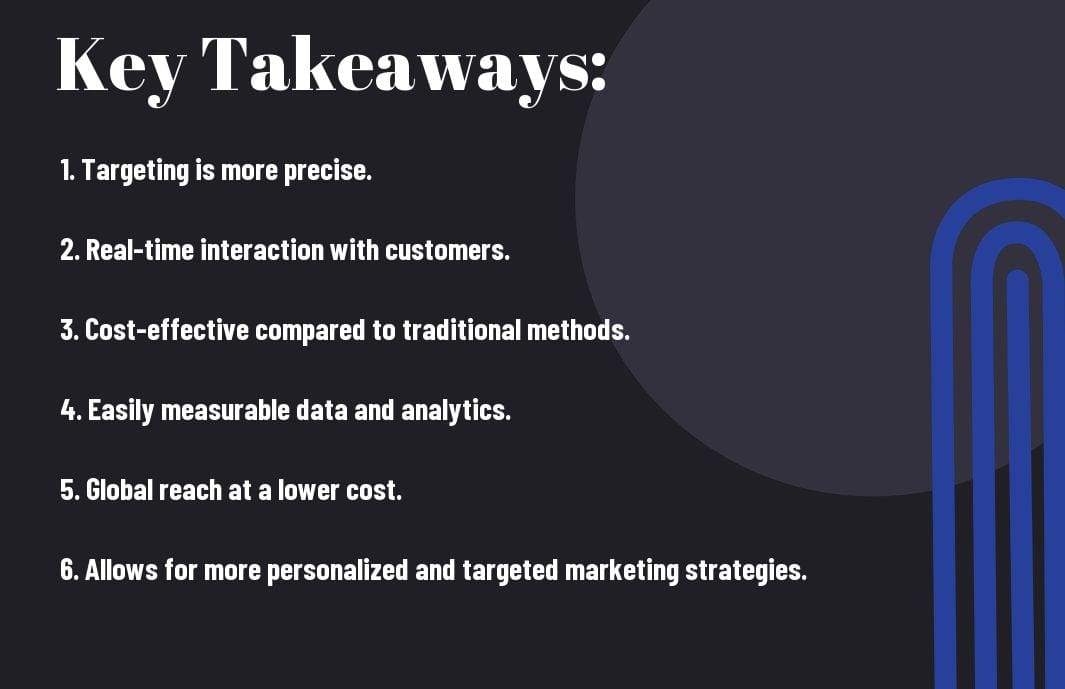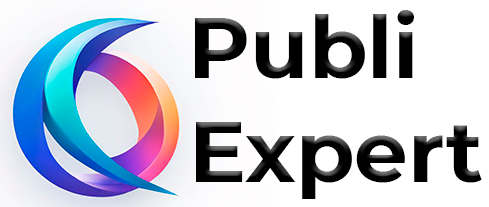There’s a significant shift in the way businesses promote their products and services in today’s digital age. Understanding the key differences between social media advertising and traditional marketing techniques is crucial for brands to effectively reach their target audiences. While traditional marketing relies on traditional channels such as TV ads, billboards, and print media, social media advertising leverages online platforms like Facebook, Instagram, and Twitter to engage with audiences in a more interactive and targeted manner. To probe deeper into how these two approaches vary and impact modern marketing strategies, check out this comprehensive comparison of Social Media Marketing vs. Traditional Marketing.
Key Takeaways:
- Targeting: Social media advertising allows for highly specific and precise targeting based on demographics, interests, behaviors, and more, whereas traditional marketing techniques may have broader and less precise audience targeting.
- Interactivity: Social media advertising offers opportunities for two-way communication, engagement, and interaction between brands and consumers, which can lead to higher levels of engagement and brand loyalty compared to traditional marketing techniques.
- Data and Analytics: Social media advertising provides detailed data and analytics on ad performance, audience engagement, and more in real-time, allowing for immediate adjustments and optimizations, whereas traditional marketing techniques may have limited access to such real-time data and insights.

The Nature of Social Media Advertising
Definition and Key Characteristics
With the rise of social media platforms like Facebook, Instagram, and Twitter, social media advertising has become a powerful tool for businesses to reach their target audience. Social media advertising refers to the process of creating and distributing ads through these platforms to promote products or services. One key characteristic of social media advertising is its ability to target specific demographics, interests, and behaviors of users, allowing for more precise and effective marketing strategies.
Targeting and Personalization
Social media advertising allows for targeted and personalized marketing campaigns. Advertisers can leverage user data such as demographics, location, interests, and online behavior to create highly tailored ads that resonate with their target audience. This level of personalization can lead to higher engagement rates and better ROI for businesses.
Definition: Social media platforms provide advanced targeting options that traditional marketing techniques do not offer. Advertisers can reach users based on their age, gender, location, interests, and even purchasing behaviors. This level of targeting ensures that ads are shown to the most relevant audience, increasing the likelihood of conversions and sales.
Interactivity and Engagement
The interactive nature of social media advertising sets it apart from traditional marketing techniques. Users can engage with ads by liking, commenting, sharing, or even making direct purchases without leaving the platform. This two-way communication fosters a sense of community and engagement between brands and consumers, ultimately leading to a more memorable and impactful advertising experience.
Interactivity: Social media advertising allows for real-time interaction between businesses and their audience. Brands can respond to comments, address concerns, and build relationships with customers directly through social media platforms. This level of engagement helps establish brand loyalty and credibility among consumers.
Traditional Marketing Techniques
Defining Traditional Marketing
Once again, when we talk about traditional marketing techniques, we are referring to the conventional methods used to promote products or services before the rise of digital marketing. Traditional marketing includes strategies such as print ads, television commercials, direct mail, billboards, and more. These methods have been the cornerstone of marketing for decades and have proven to be effective in reaching a wide audience.
Advertising Channels in Traditional Marketing
On the other hand, traditional marketing relies heavily on physical channels to reach consumers. Companies distribute advertisements through newspapers, magazines, radio stations, television networks, and direct mail. These channels have been the primary means of reaching a target audience for many years, allowing businesses to connect with consumers on a mass scale.
To compete in the traditional marketing landscape, it is vital to carefully select the right mix of advertising channels to target your desired audience effectively. While traditional marketing techniques may lack the advanced targeting options of social media advertising, they offer the benefit of reaching a broad and diverse audience through trusted and established platforms.
Comparative Analysis of Reach and Audience
Global Reach of Social Media
To understand the comparative analysis of reach and audience between social media advertising and traditional marketing techniques, it is imperative to research into the global reach of social media. Social media platforms have revolutionized the way businesses connect with their target audience on a global scale. With over 3.6 billion social media users worldwide, platforms such as Facebook, Instagram, Twitter, and LinkedIn offer businesses the ability to reach a vast and diverse audience.
| Social Media Advertising | Traditional Marketing Techniques |
| Global Reach: Social media allows businesses to reach a worldwide audience with targeted advertising campaigns. | Limited Reach: Traditional marketing techniques such as print ads, TV commercials, and radio ads have a more localized reach. |
Local and Demographic Targeting in Traditional Marketing
On the other hand, traditional marketing techniques focus on local and demographic targeting to reach a specific audience. Strategies such as direct mail, billboards, and local events enable businesses to target a specific geographic area or demographic group. While traditional marketing may lack the global reach of social media, it can be highly effective in reaching a local audience and establishing a personal connection with customers.
| Social Media Advertising | Traditional Marketing Techniques |
| Targeting Options: Social media platforms offer advanced targeting options based on demographics, interests, and behavior. | Local Targeting: Traditional marketing allows businesses to focus on specific geographic areas for targeted campaigns. |
The ability to target specific demographics in traditional marketing can be advantageous for businesses looking to engage with a niche audience or promote local events. By understanding the strengths and limitations of both social media advertising and traditional marketing techniques, businesses can develop a comprehensive marketing strategy that maximizes their reach and engagement with their target audience.
Content Creation and Campaign Execution
Content Styles in Social Media Advertising
The world of social media advertising is vast and diverse, offering various content styles to engage with the audience. Unlike traditional marketing techniques that heavily rely on print, TV, and radio ads, social media advertising allows for more interactive and dynamic content creation. From images and videos to carousel ads and influencer collaborations, the possibilities are endless.
With the rise of platforms like Instagram, Facebook, and TikTok, businesses can tailor their content styles to resonate with their target demographics. Social media advertising thrives on authenticity and storytelling, creating a more personalized connection between the brand and the consumer.
Campaign Design in Traditional Marketing
An integral part of traditional marketing techniques is the strategic design of advertising campaigns. This process involves meticulous planning, from identifying the target audience to crafting the message and selecting the right channels for distribution. Unlike social media advertising, which offers real-time engagement and feedback, traditional marketing relies on pre-planned schedules and limited interaction with the audience.
Social media advertising stands out for its ability to target specific demographics with precision and track campaign performance in real time. This dynamic approach allows for quick adjustments and optimizations to maximize reach and engagement, making it a valuable tool for modern marketers.
Measuring Impact and ROI
Analytics and Data in Social Media Advertising
Many businesses are moving towards social media advertising due to its precise targeting capabilities and the ability to measure impact in real-time. Any successful social media advertising campaign relies heavily on analytics and data collection to track key performance indicators (KPIs) such as engagement rates, click-through rates, conversion rates, and overall return on investment (ROI). By analyzing this data, businesses can make informed decisions on where to allocate their advertising budgets for maximum effectiveness.
Metrics and Assessment in Traditional Marketing
Many companies have traditionally relied on methods such as print ads, billboards, and television commercials to reach a broad audience. Impact, these traditional marketing techniques often lack the ability to provide detailed metrics on consumer behavior and campaign performance. Another drawback is the inability to adjust strategies in real-time based on the data collected, leading to potentially wasteful spending on ineffective marketing channels.
Budgeting and Costs
Cost-Efficiency of Social Media Advertising
For many businesses, social media advertising has become a game-changer when it comes to cost-efficiency. Unlike traditional marketing techniques that require a significant upfront investment with uncertain returns, social media advertising allows you to set a budget based on your specific needs and target audience. With features like targeted ads, you can reach a highly relevant audience with a minimal cost compared to traditional methods.
Expense Structures in Traditional Marketing
Expense structures in traditional marketing typically involve high costs for limited reach and engagement. From print ads to TV commercials, traditional marketing methods require a substantial investment in production, placement, and distribution. Additionally, measuring the effectiveness of traditional marketing campaigns can be challenging, leading to uncertainty in ROI. These expenses can quickly add up, especially for small businesses with limited budgets.
Traditional marketing often follows a mass marketing approach, where messages are broadcasted to a broad audience in the hope of reaching potential customers. This approach can result in wasted resources targeting individuals who may not be interested in the product or service, further adding to the expense without guaranteed results.
Trends and Future Directions
The Rise of Influencer Marketing
Marketing in the digital age has seen a significant shift towards influencer marketing. Brands are increasingly collaborating with popular social media personalities to promote their products or services. Influencers, with their large and engaged followers, have the power to sway consumer behavior and increase brand awareness. This form of marketing is perceived as more authentic and relatable as influencers often showcase products in real-life scenarios, resonating with their audience on a personal level.
As influencers continue to hold sway over consumer decisions, brands are expected to allocate a larger portion of their marketing budgets towards influencer collaborations. However, with the rise of influencer fraud and the saturation of the market, brands must carefully choose their partners to ensure authenticity and credibility.
Predictions for Traditional Marketing in the Digital Age
With the advent of digital marketing techniques, traditional marketing methods are facing a time of transformation. While some may argue that traditional marketing is becoming obsolete, there are still predictions that indicate its relevance in the digital age. Print advertising, direct mail, and television commercials may need to adapt to the changing landscape by incorporating elements of digital marketing such as targeted advertising, data analytics, and personalized content.
Summing up
To wrap up, social media advertising differs from traditional marketing techniques in several key ways. Social media allows for more targeted and personalized advertising, reaching specific audiences based on demographics, interests, and behaviors. It also allows for real-time engagement and interaction with customers, fostering relationships and building brand loyalty. Additionally, social media advertising offers more measurable and trackable results, providing valuable insights and data for optimizing future marketing strategies.
FAQ
Q: What is the difference between social media advertising and traditional marketing techniques?
A: Social media advertising involves promoting products or services on social media platforms using targeted ads or sponsored content, while traditional marketing techniques include methods like print ads, TV commercials, and billboards.
Q: Why is social media advertising considered more cost-effective than traditional marketing?
A: Social media advertising allows businesses to target specific demographics, interests, and behaviors, resulting in higher ROI compared to broad-reaching traditional marketing techniques that may not be as targeted.
Q: How does social media advertising provide better audience engagement than traditional marketing?
A: Social media platforms enable two-way communication between businesses and customers through features like comments, likes, shares, and direct messages, fostering more interaction and engagement compared to traditional one-way marketing messages.
Q: What advantages does social media advertising offer in terms of analytics and tracking compared to traditional marketing techniques?
A: Social media advertising provides detailed analytics and tracking tools that allow businesses to measure the performance of their ads in real time, track engagement metrics, and make data-driven decisions to optimize campaigns, which is more challenging with traditional marketing techniques.
Q: How does social media advertising help in building brand awareness and loyalty?
A: Social media advertising enables businesses to create targeted brand awareness campaigns, engage with customers on a personal level, and build relationships over time, leading to increased brand loyalty and advocacy compared to traditional marketing techniques.
Q: What role does influencer marketing play in social media advertising that differs from traditional marketing strategies?
A: Influencer marketing on social media involves collaborating with individuals who have a large following and credibility in a particular niche to promote products or services, leveraging their influence to reach a wider audience and build trust, which is a unique aspect not typically found in traditional marketing techniques.
Q: How does the viral potential of social media advertising differ from the reach of traditional marketing campaigns?
A: Social media advertising has the potential to go viral, reaching millions of users organically through shares, likes, and comments, which can significantly amplify the reach and impact of a campaign compared to the limited reach of traditional marketing strategies.




